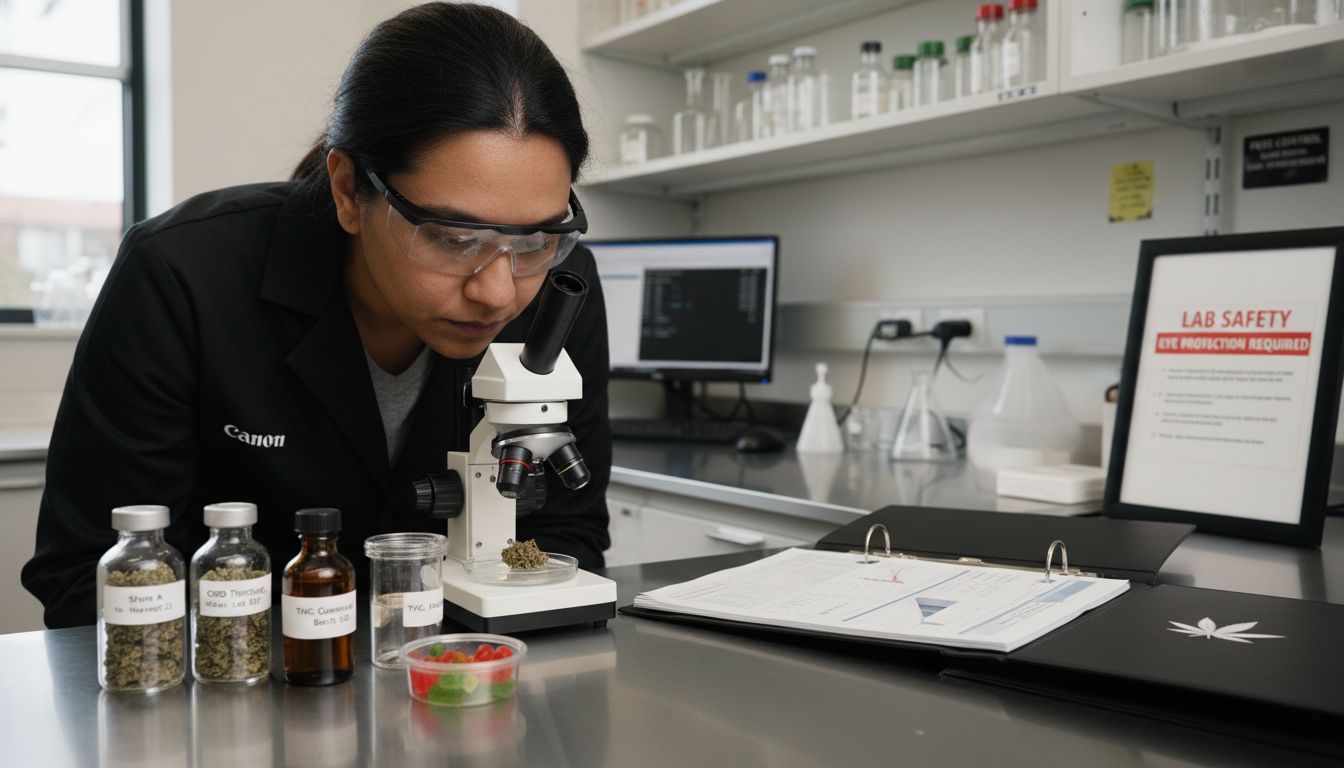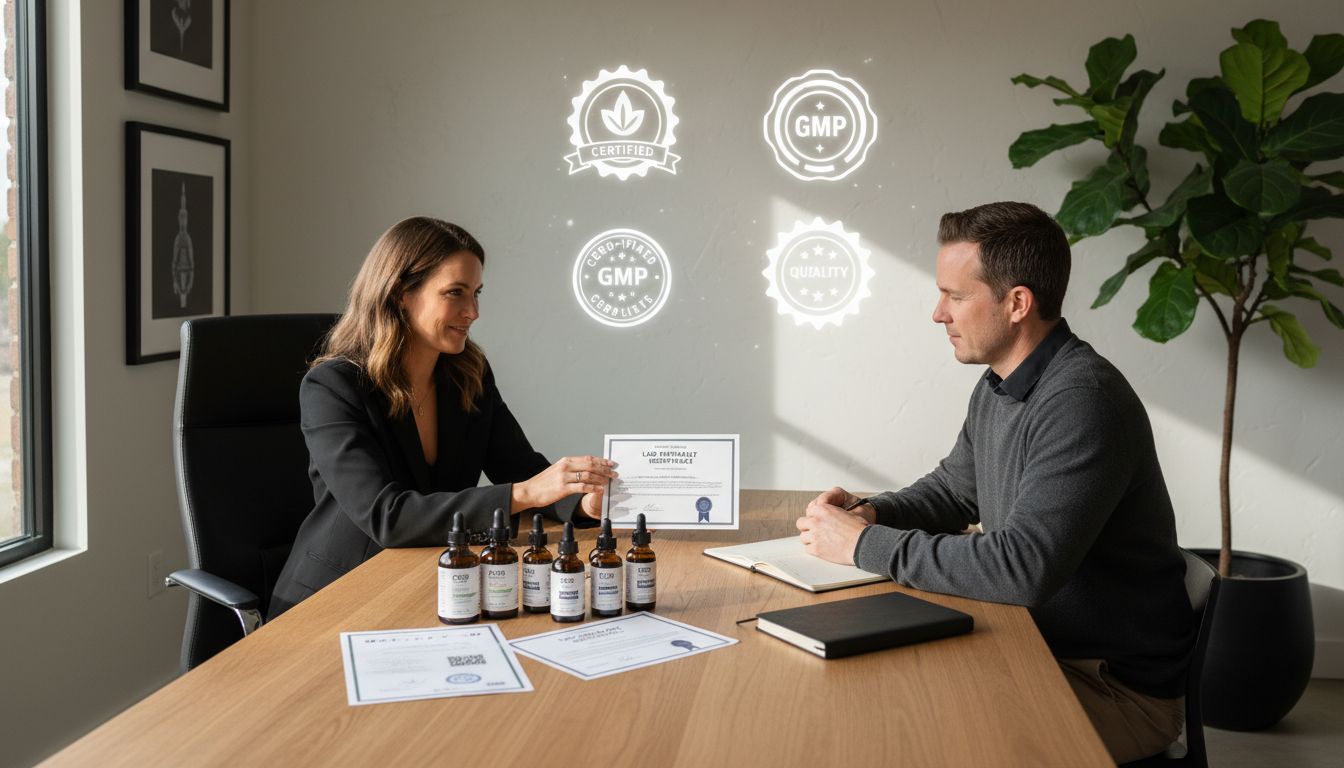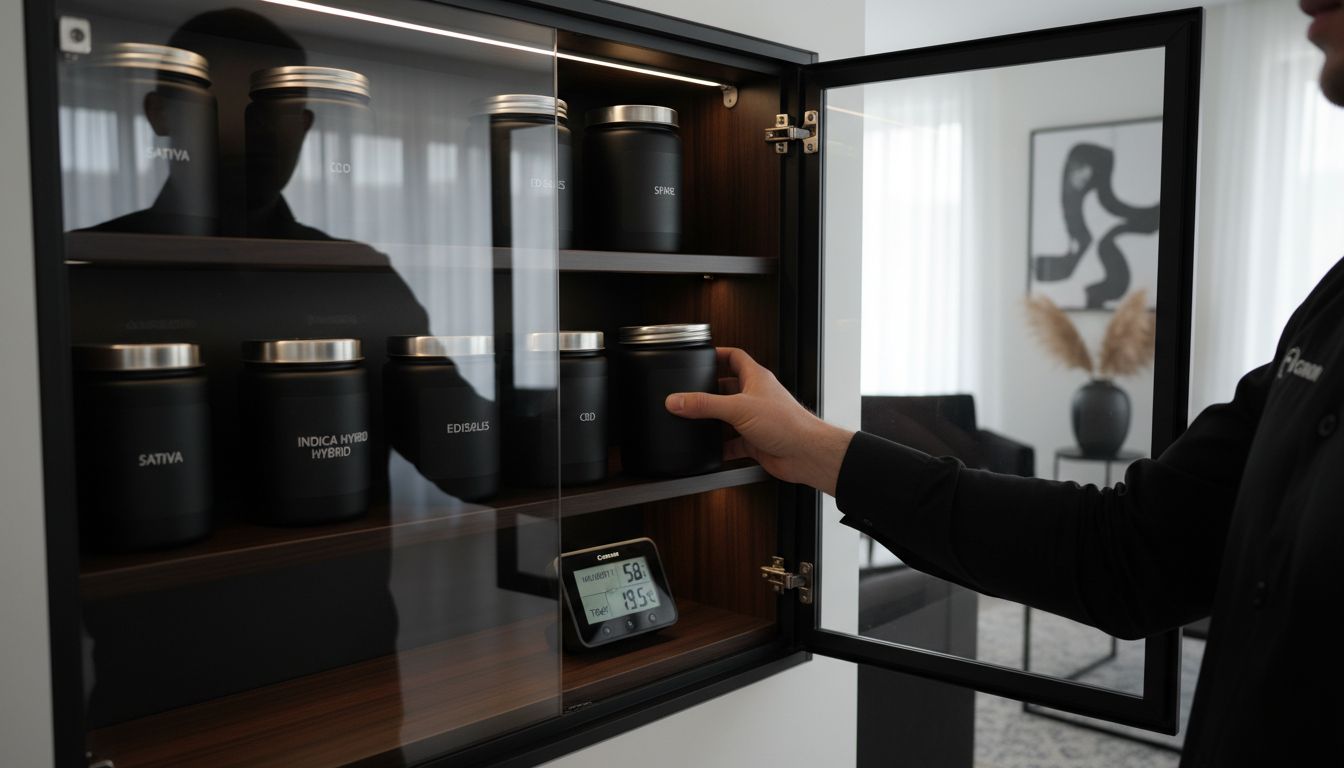How Cannabis Is Tested: Complete Guide for 2025
Written by Trevor

Nearly 30 percent of cannabis products fail lab tests for contaminants or inaccurate potency, putting users at risk without their knowledge. As the market grows, understanding what truly goes into each product matters more than ever for both safety and trust. This guide breaks down the science behind cannabis testing, explains how lab results protect you, and reveals what happens when products skip this step.
Table of Contents
- What Cannabis Testing Involves and Why It Matters
- Major Types Of Cannabis Lab Tests Explained
- Key Methods Used In Cannabis Testing Labs
- Safety Standards and Legal Testing Requirements
- Understanding Lab Results: Reading COAs and Potency
- Risks of Untested Cannabis and Common Pitfalls
Key Takeaways
| Point | Details |
|---|---|
| Importance of Testing | Cannabis testing ensures product safety and potency, protecting consumer health through comprehensive analysis. |
| Certificate of Analysis (COA) | A COA provides transparent documentation of tested cannabis products, allowing consumers to make informed decisions based on quality and safety. |
| Key Test Categories | Essential tests include cannabinoid profiling, pesticide screening, and microbial assessments to verify the safety and effectiveness of products. |
| Risks of Untested Products | Untested cannabis poses significant health risks, including chemical contamination, inaccurate potency, and potential legal issues. |
What Cannabis Testing Involves and Why It Matters
Cannabis testing is the critical scientific process that ensures product safety, potency, and consumer protection. According to cannabis.ca.gov, comprehensive testing analyzes cannabis products for multiple crucial parameters that directly impact user experience and health.
Laboratory Testing Protocols involve sophisticated scientific techniques designed to detect and quantify various elements within cannabis products. Utah Patients highlights that advanced methods like LC/MS/MS and qPCR are employed to thoroughly examine cannabis samples. These protocols screen for multiple potential contaminants and verify product composition.
The primary testing objectives encompass several key areas:
- Pesticide Detection: Identifying potentially harmful chemical residues
- Heavy Metal Screening: Measuring toxic elemental contamination
- Microbial Impurity Analysis: Checking for dangerous bacterial or fungal presence
- Cannabinoid Potency Verification: Confirming precise concentrations of active compounds
- Terpene Profile Mapping: Understanding the product’s potential therapeutic characteristics
A comprehensive Certificate of Analysis (COA) documents these extensive test results, providing transparency and scientific validation. This critical document gives consumers concrete insights into product quality, safety standards, and precise chemical composition. Understanding cannabis quality indicators becomes essential for making informed purchasing decisions and ensuring a safe consumption experience.
Major Types Of Cannabis Lab Tests Explained
Cannabis laboratory testing represents a sophisticated scientific approach to ensuring product safety and quality. Cannabis.ca.gov reveals that comprehensive lab testing covers multiple critical parameters essential for consumer protection and product verification.
Comprehensive Test Categories include several specialized analyses designed to provide a complete picture of cannabis product composition and safety. According to Greenleaf Lab, these tests fall into several key assessment areas:
- Cannabinoid Profiling: Precisely measuring concentrations of active compounds like THC and CBD
- Terpene Analysis: Identifying and quantifying aromatic compounds that influence product effects
- Pesticide Screening: Detecting potentially harmful chemical residues
- Heavy Metal Testing: Measuring toxic elemental contaminants
- Microbial Contaminant Assessment: Checking for dangerous bacterial, fungal, or mold presence
- Residual Solvent Analysis: Ensuring extraction processes haven’t left harmful chemical traces
- Moisture Content Evaluation: Verifying product stability and preventing potential microbial growth
Each test type serves a crucial function in guaranteeing consumer safety.
 Cannabis potency insights can help consumers understand how these rigorous testing protocols translate into product quality and reliable experiences. Advanced laboratory techniques like LC/MS/MS and qPCR enable scientists to perform these detailed examinations with exceptional precision, providing consumers with transparent and trustworthy product information.
Cannabis potency insights can help consumers understand how these rigorous testing protocols translate into product quality and reliable experiences. Advanced laboratory techniques like LC/MS/MS and qPCR enable scientists to perform these detailed examinations with exceptional precision, providing consumers with transparent and trustworthy product information.
Here’s a summary of major cannabis lab test categories and their main purposes:
![]()
| Test Category | Main Purpose | Safety/Quality Assessed |
|---|---|---|
| Cannabinoid Profiling | Measure THC/CBD levels | Potency Product strength |
| Terpene Analysis | Identify aroma compounds | Product effects Therapeutic properties |
| Pesticide Screening | Detect chemical residues | Consumer safety |
| Heavy Metal Testing | Measure toxic elements | Toxicity prevention |
| Microbial Assessment | Check for bacteria/fungi | Health risk reduction |
| Residual Solvent Analysis | Ensure solvent removal | Manufacturing safety |
| Moisture Content Evaluation | Verify product stability | Prevent mold/microbial growth |
Key Methods Used In Cannabis Testing Labs
Cannabis testing laboratories employ a sophisticated array of scientific methods to ensure product safety and quality. AOCS highlights that many techniques are adapted from food industry standards, providing rigorous screening protocols for cannabis products.
Advanced Analytical Techniques play a crucial role in comprehensive cannabis testing. According to Greenleaf Lab, several key methodologies are utilized for precise product analysis:
- High-Performance Liquid Chromatography (HPLC): Enables precise cannabinoid concentration measurements
- Gas Chromatography (GC): Provides detailed terpene profile analysis
- Inductively Coupled Plasma Mass Spectrometry (ICP-MS): Detects trace heavy metal contaminants
- Quantitative Polymerase Chain Reaction (qPCR): Identifies microbial contamination with exceptional accuracy
Each analytical method serves a specific purpose in validating cannabis product integrity. Exploring cannabinoid extraction processes can help consumers understand the complex scientific techniques that ensure product safety. These advanced laboratory methods transform raw cannabis materials into thoroughly vetted, scientifically validated products that meet the highest safety and quality standards.
Safety Standards and Legal Testing Requirements
Regulatory oversight plays a critical role in ensuring cannabis product safety and consumer protection. Cannabis.ca.gov reveals that the Department of Cannabis Control mandates comprehensive testing protocols designed to eliminate potential health risks and guarantee product transparency.
Legal Testing Mandates encompass a wide range of stringent requirements. According to Washington State Liquor and Cannabis Board, cannabis products must undergo rigorous screening for multiple potential contaminants:
- Water Activity Analysis: Preventing microbial growth
- Potency Verification: Confirming accurate cannabinoid concentrations
- Foreign Matter Inspection: Detecting potential physical contamination
- Microbiological Screening: Identifying dangerous bacterial presence
- Mycotoxin Testing: Checking for harmful fungal metabolites
- Pesticide Residue Detection: Ensuring chemical-free products
- Residual Solvent Evaluation: Verifying safe extraction processes
The Certificate of Analysis (COA) serves as a critical documentation mechanism, providing consumers with transparent insight into product composition and safety standards. Understanding cannabis quality indicators becomes essential for consumers seeking reliable and thoroughly tested cannabis products. These comprehensive legal requirements not only protect public health but also establish a framework of accountability within the cannabis industry.
Understanding Lab Results: Reading COAs and Potency
A Certificate of Analysis (COA) serves as the definitive scientific document providing comprehensive insights into cannabis product composition and safety. Washington State Liquor and Cannabis Board explains that consumers can request these detailed reports to make informed purchasing decisions about cannabis products.
Key Components of Lab Results are critical for understanding product quality. According to Greenleaf Lab, lab results typically break down essential information across several crucial categories:
- Cannabinoid Concentration: Precise measurements of THC and CBD levels
- Terpene Profile: Detailed breakdown of aromatic compound percentages
- Contaminant Screening: Comprehensive testing for potential harmful substances
- Potency Verification: Accurate representation of product strength
- Batch-Specific Information: Unique identifiers for product traceability
Reading a COA requires understanding key scientific metrics and interpretation techniques. Understanding cannabis potency explained can help consumers decode these complex laboratory reports. Ultimately, these documents represent more than just numbers—they’re a transparent window into product safety, composition, and potential effects, empowering consumers to make educated choices about their cannabis consumption.
Risks of Untested Cannabis and Common Pitfalls
Untested cannabis represents a significant health and safety risk for consumers, with potential consequences that extend far beyond simple product quality concerns. CannaCon emphasizes that without standardized testing, consumers may face serious health hazards and potential legal complications due to misrepresented product contents.
Primary Risks of Unverified Cannabis Products include multiple potential dangers that can compromise user safety:
- Chemical Contamination: Potential exposure to harmful pesticides and heavy metals
- Microbial Threats: Risk of dangerous bacterial or fungal contamination
- Inaccurate Potency: Misleading information about cannabinoid concentrations
- Unpredictable Effects: Inconsistent product performance and potential health risks
- Legal Vulnerability: Potential legal issues from unverified product composition
The cannabis industry faces significant challenges in maintaining consistent testing standards. According to Utah Patients, issues like ‘lab shopping’ can lead to unreliable testing results, where producers seek laboratories that might provide more favorable outcomes. Buying cannabis online safely becomes crucial in navigating these potential pitfalls, emphasizing the importance of purchasing from reputable sources that prioritize comprehensive product testing and transparency.
Discover Confidence in Every Cannabis Product You Choose
Navigating the complex world of cannabis testing can feel overwhelming. The article shows how crucial rigorous lab testing is for ensuring product safety, potency, and overall quality. You deserve cannabis products that are transparently lab tested for pesticides, heavy metals, microbial contaminants, and precise cannabinoid profiles. Avoid the risks of untested or misrepresented cannabis by choosing trusted sources that prioritize lab results and legal compliance.
Find your next safe and effective product in The THCa Prestige Vault – California Blendz where every flower undergoes strict testing to guarantee purity and potency.

Experience peace of mind with expertly curated, lab-certified cannabis products at California Blendz. Explore our full selection including The Founder’s Collection – California Blendz to find items that match your wellness goals. Act now and shop confidently knowing transparency and quality are our top priorities.
Frequently Asked Questions
What is cannabis testing and why is it important?
Cannabis testing is a scientific process that evaluates cannabis products for safety, potency, and quality. It ensures consumer protection by analyzing products for contaminants, verifying cannabinoid concentrations, and confirming overall product integrity.
What types of contaminants are tested in cannabis products?
Cannabis products are tested for various contaminants, including pesticides, heavy metals, microbial impurities, and residual solvents, to ensure product safety and prevent health risks.
How can I read and understand a Certificate of Analysis (COA) for cannabis?
A COA presents detailed information about a cannabis product’s composition, including cannabinoid concentrations, terpene profiles, and contaminant screenings. To read it effectively, look for key metrics such as THC and CBD levels, as well as any identified contaminants.
What are the risks of using untested cannabis products?
Untested cannabis products can pose significant health risks, including chemical contamination, microbial threats, inaccurate potency information, unpredictable effects, and potential legal issues due to misrepresented product contents.








